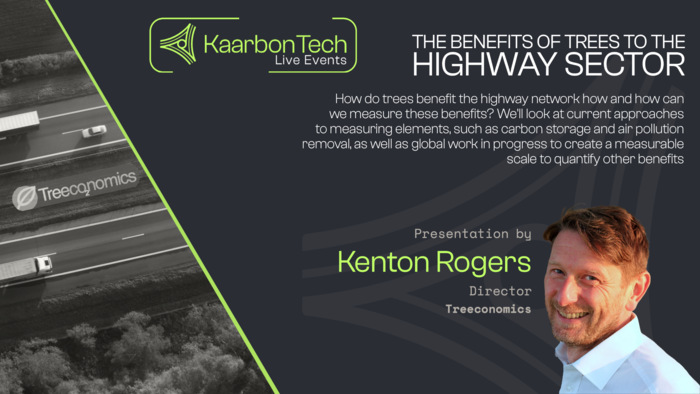Trees play a vital part in any landscape, and we’re well aware of their benefits, creating habitats for wildlife, improving the soil and cleaning the air. At our recent Tree SMART Live event, we invited the Director of Treeconomics, Kenton Rogers, to explain the specific benefits of trees to the highway sector.

Treeconomics is a social enterprise, working with a range of organisations including public bodies, community groups and research organisations to highlight and promote the value of trees. Their vision is to enable sustainable treescapes, gathering information to help make more informed decisions about our natural resources.
The importance of urban forests
Urban forests are often an overlooked and undervalued resource. With over 50% of the global population living in urban areas and that figure rising fast, it’s vital that we recognise the value of trees in these locations. The United States Department of Agriculture estimates that around 36 million urban trees are lost in America each year due to development, vandalism and simply old age. Comparing that to Greater London’s tree population of 8 million, it’s no small amount that’s being lost in the USA each year. Spin that up to a global scale and the numbers increase exponentially. Additionally, 67% of urban forests in the UK have no proactive management, or even appear on an inventory – no one knows they exist, or how healthy they are.
These urban trees are essential in providing benefits to our towns and cities across the UK. Around 100 different benefits have been identified from natural ecosystems, and of those, around 20 relate specifically to urban trees. From those, we can quantify ten benefits and gauge the effect of those trees, and finally, there are five of those benefits that we can actually put a monetary value on.
These five benefits are:
Stormwater attenuation and reduced surface flooding
Pollution filtration
Carbon storage
Carbon sequestration
Energy savings on residential buildings (from reduced heating and air conditioning)
Relating the benefits to roads
Trees around roads have the prime benefit of pollution removal, collecting pollutants on the surfaces of leaves and bark. Hedges and shrubs are lower to the source – vehicle exhausts – however a mixture of trees, hedges and shrubs give the best result, acting as a great buffer for collecting pollution. In London, around 14% of road transport emissions can be filtered through this urban forest, providing a service worth around £150 million each year, valued using the UK’s Department of Environment and Climate Change ‘social damage costs’.
Trees are very efficient at cooling roads and pavements in hot weather. Although we may not experience so many extreme temperature events here in the UK, dark road surfaces absorb the heat, and when temperatures hit the high 20s, as they often do in summer months, the actual temperature of the darker road surface is much higher and they start to soften. With research ongoing, trees are revealing their ability to prolong the life of asphalt, with tree canopies providing a cooling effect.
Studies have shown that a shelter just 15 metres wide can influence noise reduction on roads. This is important as exposure to noise has been shown to be a key contributor to increased stress and therefore, poorer health. With careful planning and management, noise reduction can be a major benefit of planting the right trees in the right places. A mix of different species, sizes, spacings and better soil combine to absorb more sound. Trees need to be healthy, with a careful management plan to ensure that strimming and mowing during the summer months doesn’t damage trees and have long term detrimental effects on them.
Planning for the future
Trees begin to realise major benefits at around 20 to 30 years old, meaning that they must be well cared for to ensure they survive and thrive well beyond this point. Replacing younger trees that may die prematurely negates any potential benefit, simply incurring costs for new tree stock.
Management tools are helpful in ensuring the health and longevity of urban trees. Collecting data on each tree helps to build a picture of the health, species spread and location of trees across the country. However, data alone doesn’t equal action. It’s essential that the data is interpreted and analysed to produce results that can be used for future management.
i-Tree Eco is a free online resource that uses open-source data to provide information on the benefits of different trees. It can be used to help inform decisions on tree planting as well as tree removal, offering vital reliable information on the benefits of trees and how long it will be before these benefits have outweighed the detrimental impact of development.
Our Tree SMART solution goes one extra step, taking specifically collected data and using it to plan proactive maintenance programmes and bespoke management solutions, to ensure trees thrive well into the future.
Find out more about Treeconomics’ work here, and explore our Tree SMART solution here. See more about our Tree SMART event in our KaarbonTech News pages.

